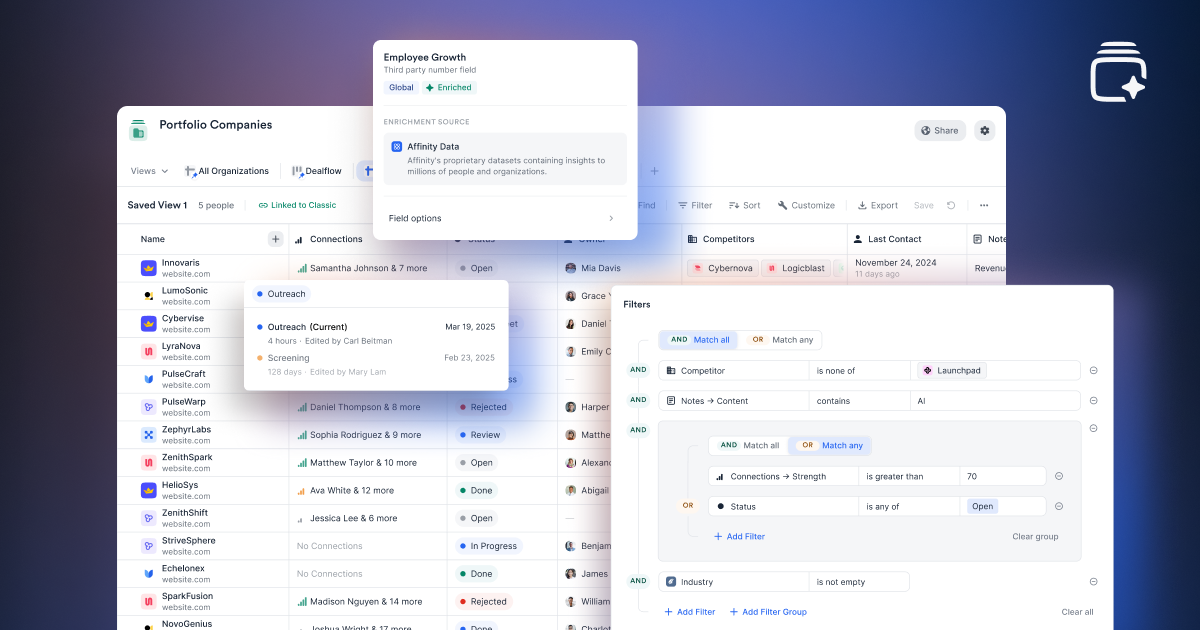Did you know nearly 45% of deals come from connections in a dealmaker’s existing network?
For better or for worse, venture capitalists rely on relationships over data when they’re sourcing deals. While this practice won’t fundamentally change any time soon, VCs who want to become more efficient in 2026 are layering data on top of their network to source deals a lot faster.
Data points are crucial to the start of a successful investment. Signals like headcount growth, growth rate, funding stage, and founder background all help to qualify or disqualify any relationship from turning into a deal.
The thing is, it takes a long time for associates to sort through this data to uncover anything meaningful. We published a guide on how to speed up this process, but before you dive in, check out some highlights here.
Step 1: Consolidate data sources
According to research from our 2026 Private CapitalPredictions Report report, 51% of VCs use at least four data sources when researching a deal. Associates spend hours pooling data from websites, LinkedIn pages, Pitchbook, industry publications, etc. to find two things: promising companies and the best possible introduction path to them.
But there’s a problem. All associates are separately looking in the same places. That means they’re bringing similar lists to general partners, who want as many fresh opportunities as possible.
The first step to better deal sourcing in 2026 is transparent consolidation, which means:
- Pulling data from your CRM, LinkedIn, associate emails, calendars, etc. into one place
- Making that data visible to your entire team on one platform
- Adding all relevant data points to a centralized company record
The more you can customize that company record, the better. For example, VU Venture Partners customizes their deal records with their own in-house calculation of market size—which is mandatory for presenting a deal to partners. “We don't allow anyone to present a deal during a partners meeting,” says Skyler Fernandes, founder and general partner, “if they haven’t filled out the market size calculation themselves.”
To learn more about how to execute this step, refer to Chapter 1 of the 2025 Deal Sourcing Guide.
Step 2: Analyze relationship data trends
Consolidation leads to pattern recognition. When you centralize data about your network and deal pipeline, you’ll start to notice certain characteristics as indicators of success.
From a relationship perspective, you may notice that company founders who meet your deal criteria have similar backgrounds. This information may lead you to seek out other sources of information from niche publications, institutions, or platforms.
From a data perspective, you’ll begin to see where your best deals are coming from. When you can break down close rate by source, you can allocate your resources to activities that keep deals moving through the pipe.
To learn more about how to execute this step, refer to Chapter 3 of the 2025 Deal Sourcing Guide.
Step 3: Map your network for customized outreach
It’s a fact of life: warm intros > cold outreach, almost every single time.
Deals are made when someone who knows someone introduces two ‘someones’ who hit it off. Firms spend hours tracking down connectors who can get them in the right rooms with the right people.
Relationship intelligence platforms are helping dealmakers cut down on those hours. By pulling LinkedIn data, emails, calendar invites, and more from all employees into one platform, firms can map out their entire network so they know the true strength of every relationship at their disposal.
For example, if you know a founder or fellow investor has helped source valuable deals in the past, you should be able to cross-reference their network with yours to find points of connection. That way, your outreach and subsequent conversations are more informed than if you start them from scratch.
Relationship intelligence means less time to generate personalized conversations that confirm to prospects that you’ve done your diligence, understand their mission, and can offer unique support that other firms can’t.
To learn more about how to execute this step, refer to Chapter 3 of the 2025 Deal Sourcing Guide.
For more advice on how to strengthen your deal sourcing, read our VC edition of our 2025 Deal Sourcing Guide. Here are three things you can expect to find out:
- More advice from experts on how to source deals more efficiently
- How to use data and relationships to guide your sourcing decisions
- The technologies that will improve your workflows
{{sourcing-deals-2023="/rt-components"}}







.png)



.webp)
.webp)